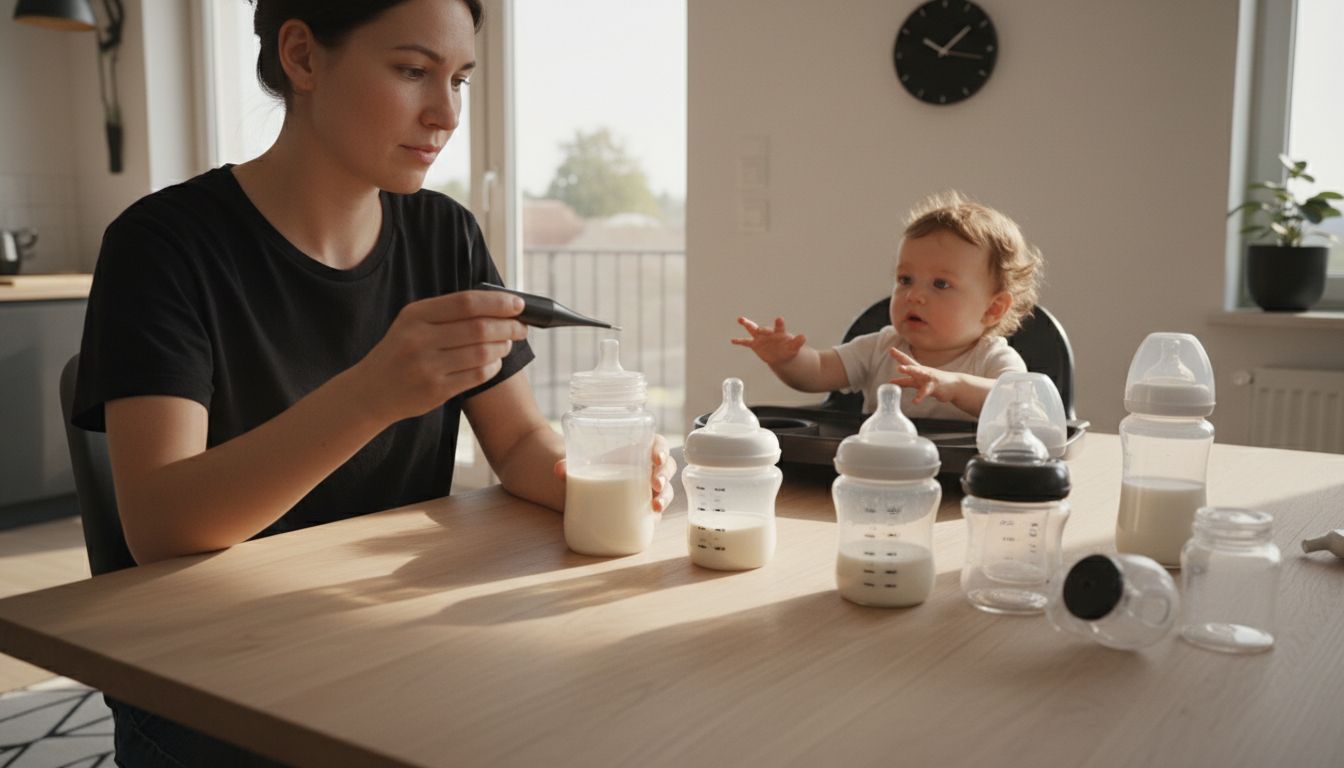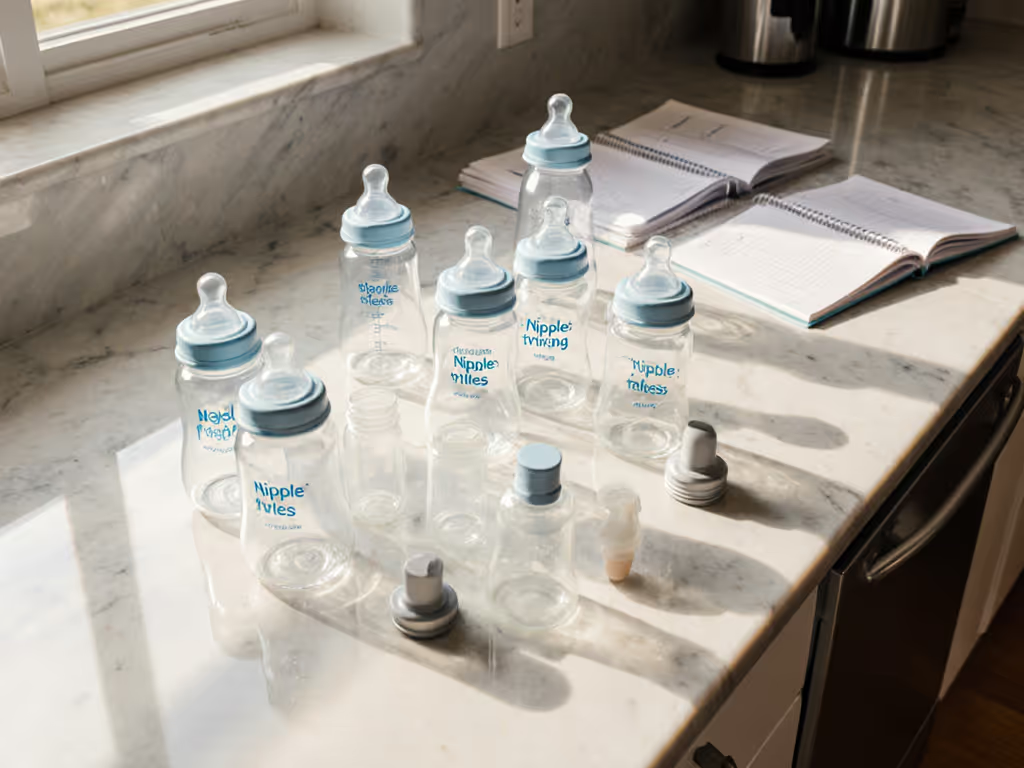
Why Babies Refuse Bottle: Complete Expert Guide

Nearly half of parents report their baby has refused a bottle at some point, leaving many families searching for answers. Bottle refusal is more than picky feeding; it is a form of communication shaped by comfort, emotional needs, and even subtle sensory details. Understanding the science and psychology behind this behavior can help you move beyond frustrating trial and error toward practical solutions that truly work for your unique child.
Key Takeaways
| Point | Details |
|---|---|
| Understanding Refusal | Bottle refusal in babies is a complex interplay of sensory, emotional, and developmental factors rather than a simple preference. |
| Key Causes | Factors such as nipple preference, temperature sensitivity, and emotional discomfort significantly influence a baby's likelihood to refuse a bottle. |
| Behavioral Indicators | Babies communicate refusal through various behaviors, including complete rejection and physical resistance, indicating their comfort levels and preferences. |
| Strategic Feeding | Successful bottle introduction requires a responsive approach, including optimal timing, appropriate nipple selection, and gradual introduction to enhance comfort and acceptance. |
Understanding Bottle Refusal in Babies
Bottle refusal might seem like a mystery, but it's actually a complex interaction between your baby's comfort, feeding preferences, and emotional experience. Bottle rejection isn't a simple yes or no scenario but a nuanced communication from your infant about their feeding needs and sensory experiences.
Research reveals fascinating insights into why babies might resist bottle feeding. A comprehensive study involving 841 UK mothers explored the psychological and socio-cultural factors behind bottle refusal, highlighting that this behavior is rarely about the bottle itself. Instead, it often represents a complex interplay of sensory, emotional, and developmental factors.
Psychological triggers can include everything from nipple texture and temperature to the baby's current mood and physical comfort.
Several key factors contribute to bottle refusal:
- Nipple Preference: Babies who are exclusively breastfed might find bottle nipples unfamiliar or uncomfortable
- Temperature Sensitivity: Slight variations in milk or bottle temperature can trigger rejection
- Flow Rate Differences: Bottle nipples often have different flow rates compared to maternal nipples
- Emotional Connection: Babies associate feeding with comfort and maternal bonding
Interestingly, mothers' perspectives provide critical insights into this phenomenon. Research examining maternal experiences identified that bottle refusal isn't just a feeding challenge but a deeply individual experience. Some babies are more sensitive to changes in feeding routines, while others adapt more quickly. Understanding your specific baby's unique preferences becomes key to successful bottle introduction.

Major Causes of Bottle Feeding Refusal
Bottle feeding refusal is a complex challenge that extends far beyond a simple preference for breastfeeding. Research indicates multiple intricate factors contribute to this behavior, transforming what seems like a straightforward feeding method into a nuanced psychological and physiological experience for infants.
Scientific studies have revealed several significant causes underlying bottle feeding resistance. A comprehensive research involving UK mothers pinpointed key factors such as previous bottle rejection experiences, frequency of intended bottle feeding, and the precise age of first bottle introduction. These elements suggest that bottle refusal isn't random but a calculated response based on the baby's developmental stage and prior sensory memories.

The primary causes of bottle feeding refusal can be categorized into several critical domains:
- Sensory Mismatch: Differences between bottle nipple texture and maternal nipple
- Feeding Technique Variations: Contrasts in milk flow and suckling mechanics
- Psychological Comfort: Disruption of emotional bonding experienced during breastfeeding
- Developmental Timing: Age-related readiness for alternative feeding methods
- Physiological Adaptability: Individual differences in oral-motor skill development
Research further illuminates the profound psychological dimensions of bottle refusal. Mothers' perspectives reveal that the emotional connection inherent in breastfeeding cannot be easily replicated through bottle feeding. Babies perceive feeding not just as a nutritional activity but as an intimate, comforting interaction. Understanding these nuanced psychological underpinnings helps parents approach bottle introduction with greater empathy, patience, and strategic planning.
Common Types of Refusal Behaviors
Bottle refusal behaviors represent a complex spectrum of infant communication, ranging from subtle signals to more pronounced rejections. These behaviors are not random but strategic expressions of a baby's comfort, preference, and developmental readiness for alternative feeding methods.
Research has meticulously documented the intricate ways babies communicate their resistance to bottle feeding. Scientific studies involving extensive maternal observations have revealed a nuanced taxonomy of refusal behaviors. Behavioral patterns can be classified into distinct categories, each offering unique insights into the baby's underlying emotional and physiological state during feeding attempts.
The primary types of bottle refusal behaviors include:
Here's a summary comparing the main types of bottle refusal behaviors:
| Refusal Behavior | Key Characteristics | Typical Baby Responses |
|---|---|---|
| Complete Rejection | Immediate refusal<br>No feeding attempt | Turns away<br>Clamps mouth<br>Crying |
| Partial Acceptance | Feeds intermittently<br>Frequent stops | Starts, then stops<br>Appears distracted |
| Conditional Acceptance | Accepts only with certain methods | Requires specific position<br>Caregiver changes |
| Physical Resistance | Active resistance<br>Body movement | Pushes bottle<br>Arches back |
| Emotional Signaling | Expresses distress<br>Seeks comfort | Whimpering<br>Looks for breastfeeding |
- Complete Rejection: Consistent and immediate turning away from the bottle
- Partial Acceptance: Intermittent willingness to feed, with frequent interruptions
- Conditional Acceptance: Feeding only under specific circumstances or with particular techniques
- Physical Resistance: Pushing the bottle away, arching back, or becoming visibly distressed
- Emotional Signaling: Crying, whimpering, or seeking immediate comfort through breastfeeding
Understanding these behaviors requires a nuanced approach. Infant communication through feeding refusal is rarely about the bottle itself, but more often a complex interaction of sensory experiences, emotional needs, and developmental stages. Parents who recognize these subtle signals can adapt their feeding strategies, creating a more responsive and comfortable feeding environment that respects the baby's individual preferences and developmental journey.
Key Signs a Baby Is Refusing Bottle
Bottle refusal is a nuanced communication method that babies use to express their feeding preferences and emotional state. Understanding the subtle signals can help parents recognize and address potential issues before they become persistent feeding challenges.
Research has systematically documented the key indicators that suggest a baby is actively resisting bottle feeding. Scientific studies involving maternal observations have revealed a consistent pattern of behavioral cues that signal bottle rejection. These signs go beyond simple food disinterest and represent complex emotional and physiological responses to feeding attempts.
The most prominent signs of bottle refusal include:
- Physical Avoidance: Consistently turning head away when bottle is presented
- Emotional Distress: Immediate crying or whimpering upon bottle introduction
- Postural Resistance: Arching back, pushing bottle away with hands or mouth
- Feeding Interruption: Frequent stopping, starting, and overall inconsistent feeding
- Comfort Seeking: Actively trying to return to breastfeeding or seeking maternal comfort
- Oral Rejection: Clamping mouth shut or repeatedly pushing bottle nipple out
Recognizing these signs requires keen observation and patience. Infant communication through feeding behaviors is deeply personal and context-dependent. Parents who approach bottle refusal with empathy and flexibility can develop strategies that respect their baby's unique feeding preferences, ultimately creating a more positive and stress-free feeding experience for both child and caregiver.
Effective Strategies to Encourage Bottle Feeding
Bottle feeding success requires a strategic, patient approach that respects your baby's unique developmental needs and emotional comfort. Parents who understand that bottle acceptance is a learned skill can transform potentially challenging feeding experiences into positive, nurturing interactions.
Research highlighting responsive feeding techniques provides critical insights into encouraging bottle acceptance. Studies involving nursing professionals have identified specific strategies that stimulate infant engagement and promote successful bottle feeding. Responsive feeding involves more than just presenting a bottle; it requires a holistic understanding of the baby's physiological and emotional readiness.
Key strategies for encouraging bottle feeding include:
- Timing Optimization: Choose feeding times when the baby is alert but not overly hungry
- Temperature Precision: Ensure milk temperature closely mimics body temperature
- Positioning Comfort: Use varied holding positions that feel similar to breastfeeding
- Gradual Introduction: Start with small amounts and gentle approaches
- Caregiver Consistency: Have multiple trusted caregivers attempt bottle feeding
- Nipple Selection: Experiment with different nipple shapes and flow rates
- Sensory Matching: Warm the bottle, mimic breastfeeding motion during feeding
Successful bottle feeding is an art of patience and adaptation. Infant feeding dynamics are complex and highly individualized. Parents who approach bottle introduction with flexibility, empathy, and a willingness to experiment can transform initial resistance into a comfortable, nurturing feeding experience that supports both nutritional needs and emotional bonding.
Bottle Selection, Nipple Choice, and Feeding Techniques
Bottle and nipple selection represents a critical intersection of infant nutrition, comfort, and developmental support. Parents navigating this complex landscape must understand that each baby has unique feeding requirements that demand careful, personalized approach to bottle and nipple choice.
Research emphasizes that selecting appropriate feeding equipment goes far beyond aesthetic considerations. Responsive feeding practices involve understanding intricate details of bottle design, nipple structure, and how these elements interact with an infant's natural sucking mechanisms. Scientific studies have demonstrated that precise selection can significantly impact feeding success, reducing potential resistance and supporting healthy nutritional intake.
Key considerations for bottle and nipple selection include:
- Material Compatibility: Choose bottles that mimic breastfeeding sensory experience
- Nipple Flow Rate: Match nipple speed to baby's sucking strength and age
- Anatomical Design: Select nipples that support natural oral development
- Venting Mechanisms: Reduce air intake to minimize gas and discomfort
- Size and Shape: Ensure nipple proportions match infant's mouth structure
- Texture Sensitivity: Consider silicone vs. latex materials based on baby's preferences
- Age-Appropriate Features: Adapt bottle design to developmental feeding stages
Successful feeding techniques require ongoing observation and flexibility. Infant feeding adaptation is a dynamic process that demands parents remain attentive and responsive to their baby's evolving needs. By approaching bottle feeding as a collaborative journey of discovery, parents can transform potentially challenging experiences into moments of nurturing connection and nutritional support.
Overcome Bottle Refusal With Expert Guidance and Customized Solutions
If your baby is showing signs of bottle refusal such as physical avoidance, emotional distress, or conditional acceptance, you are not alone. These behaviors reveal the complex emotional and sensory challenges infants face when transitioning to bottle feeding. Recognizing factors like nipple flow rate, bottle temperature, and the need for emotional comfort can make all the difference in creating a positive feeding experience. Understanding these pain points helps you tailor feeding techniques that nurture your baby's unique preferences, reducing stress for both you and your little one.
Discover practical tools and personalized advice at Family Bottle Fit designed to optimize your bottle selection and feeding methods. Whether you need insights on matching nipple types, venting systems, or finding the right bottle material, our comprehensive guides empower you to address common issues like nipple confusion, feeding interruption, and flow mismatches. Ready to transform feeding time into a calmer and more effective routine? Visit Family Bottle Fit now to explore expert-reviewed solutions and start customizing a feeding approach that fits your baby's needs perfectly.
Frequently Asked Questions
Why do babies refuse bottles?
Bottle refusal often stems from a complex interplay of factors such as nipple preference, temperature sensitivity, different flow rates, and emotional connections with breastfeeding. Babies may find bottle nipples uncomfortable or unfamiliar and may also reject bottles during certain emotional states.
What are the common signs that my baby is refusing a bottle?
Signs of bottle refusal can include physical avoidance (turning the head away), emotional distress (crying when the bottle is presented), postural resistance (arching back), feeding interruptions, comfort-seeking behaviors, and oral rejection (clamping mouth shut).
How can I encourage my baby to accept a bottle?
You can encourage bottle feeding by optimizing feeding times when the baby is alert but not overly hungry, ensuring milk temperature mimics body temperature, using varied comfortable holding positions, gradually introducing the bottle, and experimenting with different nipple shapes and flow rates.
What factors should I consider when choosing a bottle and nipple for my baby?
Key considerations include material compatibility (mimicking breastfeeding), nipple flow rate suitable for the baby’s sucking strength, anatomical design supporting oral development, venting mechanisms to reduce gas, size and shape that match the infant’s mouth, and texture sensitivity based on the baby’s preferences.
Related Articles


7 Common Bottle Feeding Mistakes Parents Should Avoid

Bottle Compatibility: Everything You Need to Know

Complete Guide to Breast-Like Nipples for Babies

